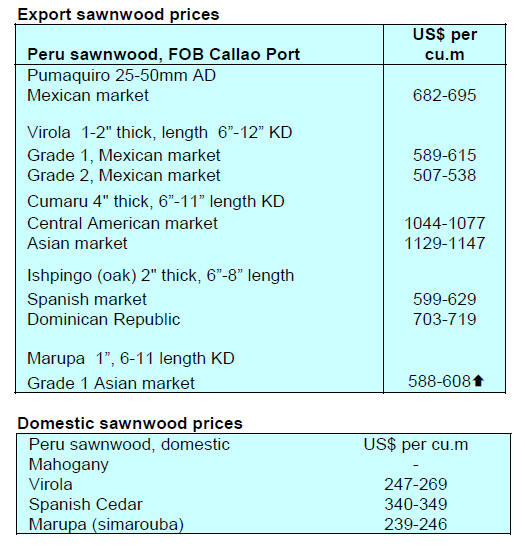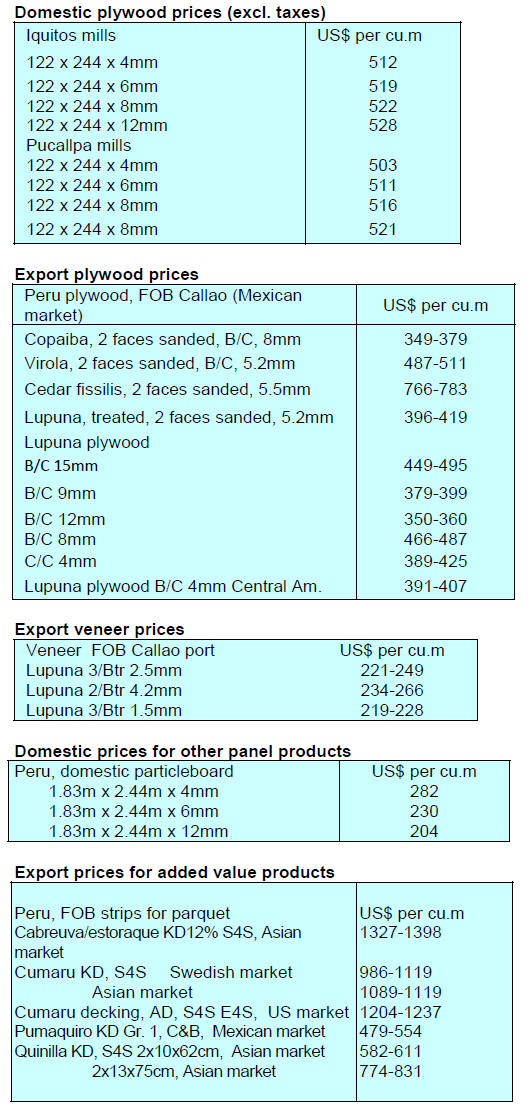4.
INDONESIA
Expanding SVLK at the
global level
At the recent Forest Governance, Markets and Climate
(FGMC) Stakeholder Forum held in London the FLEGTVPA
cooperation between Indonesia and the UK was
strengthened.
The UK Government Minister in charge of International
Environment and Climate, Animal Welfare and Forests
expressed appreciation for the achievements by Indonesia
in improving forest governance. Purwadi Soeprihanto,
Secretary General of the Association of Indonesian Forest
Concession Holders, supports efforts to expand the
recognition and the acceptance of SVLK at a global level
saying "business to business cooperation needs to be
strengthened to promote the FLEGT VPA between
Indonesia, European Union and UK as well as to build
broad recognition of the Indonesian national standard at
the global level.
See:
https://industri.kontan.co.id/news/sistem-verifikasi-legalitaskayu-svlk-diperluas-ekspor-kayu-indonesia-makin-moncer
Low cost and efficient timber identification
Indonesia will develop a standardised system for wood
identification to support the promotion of sustainable
timber to the global market.
The Head of the Instrument Standardisation Agency in the
Ministry of Forestry, Ary Sudijanto, said that an accurate
and efficient species identification system and data centre
for easy and cheap identification and tracking of timber
will support verification and trade in sustainable timber.
This system could be the answer to the current situation
where customs officials and law enforcement officers have
difficulty to validate timber export documents.
A researcher from the National Research and Innovation
Agency (BRIN), Ratih Damayanti, revealed that to support
the development of a wood identification system Indonesia
has developed an Automatic Wood Identification
Application (AIKO-KLHK). She added “There are about
1,300 timbers that can be identified using AIKO-KLHK".
A portable device is currently being developed.
See:
https://forestinsights.id/2022/05/06/indonesia-kembangkanstandar-sistem-identifikasi-kayu-murah-dan-efisien-cegahperdagangan-ilegal/
Public/private promotion of Lightwood
The Ministry of Trade, through the Directorate General of
National Export Development and Fairventures
Worldwide signed a memorandum of understanding on the
development of lightwood especially sengon (Albizia sp)
and jabon (Anthochepalus sp). The MoU was signed by
the Director General of National Export Development,
Didi Sumedi and CEO of Fairventures Worldwide Megan
King. In addition to the MoU, the Ministry of Trade and
Fairventures Worldwide also signed a Technical
Arrangement (TA) to follow up on the MoU in detail.
Activities to be undertaken include educating consumers
about the benefits of lightwood, establishing a lightwood
innovation centre and conducting training on the use of
lightwood. In addition, the Ministry of Trade and
Fairventures Worldwide will also promote the Timber
Legality Verification System (SVLK) in Europe fostering
2000 sengon wood farmers with an area of 2000 ha of
sengon plantations and distribute two million sengon
seedlings.
See:
https://wartaekonomi.co.id/read410073/kemendag-tandatangani-mou-pengembangan-kayu-ringan-berkelanjutan
Social forestry aids economic recovery
Indonesia’s social forestry policy can deliver alternative
livelihood sources to rebuild the economy after the Covid-
19 pandemic as it will provide communities with access to
managed forests and assistance in marketing. This was
stated by Agus Justianto, Director General of Sustainable
Forest Management at the Ministry of Environment and
Forestry at the Asian Forest Cooperation Organization
Ministerial Meeting at the World Forestry Congress in
Seoul.
See:
http://agroindonesia.co.id/perhutanan-sosial-bantuindonesia-pulihkan-ekonomi-pasca-pandemi-covid-19/
Indonesia seeks ASEAN cooperation in peatland
management
Indonesia has invited countries in Southeast Asia to work
closely together for sustainable peatland management in
support of economic growth and maintainance of
ecological balance. Indonesian Ambassador to the
Republic of Korea, Gandi Sulistyanto, said that tropical
peatland in Southeast Asia provides many benefits for the
region from providing timber and non-timber forest
products, water reserves and helping in flood control.
Ambassador Gandi said the Indonesian government is
strongly committed to managing peat ecosystems by
building a monitoring and control system for forest and
land fires.
A document outlining a sustainable peat management
strategy has been released which can serve as a guide for
ASEAN countries. Vong Sok, Head of the Environment
Division and Assistant Director of the Sustainable
Development Director at the ASEAN Socio-Cultural
Community said that a project for implementing
sustainable peat management is currently being piloted in
countries in the Mekong Delta.
See:
https://republika.co.id/berita/rbfn70383/ri-undang-negaranegaradunia-untuk-bantu-pengelolaan-gambut-lewat-itpc
EconomicgGrowth in the first quarter
Statistics Indonesia reported a 5.01% year on year growth
in the first-quarter attributed to recovering economic
activities post Covid-19 pandemic. Statistic Indonesia
Head, Margo Yuwono, also mentioned the growth was
built on a very low baseline. In the same quarter of 2021
economic growth was minus 0.7%.
See:
https://en.tempo.co/read/1589865/statistics-indonesiabreaks-down-5-01-percent-economic-growth-in-q1

5.
MYANMAR
Export registrations revoked -
timber companies
included
According to the Ministry of Commerce over 300 exporter
registrations have been revoked for the failure to abide by
the Central Bank regulations on foreign currency
exchange.
The Central Bank issued a rule that foreign currency
export earnings must be deposited in a domestic bank
account within a defined time from the export date.
Export earnings for exports to Asian countries must be
credited within 45 days of the export date and export
earnings from exports to other countries must be deposited
to the bank account within 90 days of the export date.
According to a 6 May statement from the Ministry of
Commerce and the Central Bank the government will take
action against exporters who do not follow the amended
laws. Their export certificates will be suspended until the
earnings are banked as required.
In addition to the 346 companies who had their export
licenses revoked in 2021, this year, as of 27 April, 177
exporters have also had their licenses revoked for noncompliance
with the banking regulation.
It is learnt that about 40 timber manufacturers are among
the companies effected. Some complain they were
wrongly placed om the list of companies whose export
credentials should be revoked.
See:
https://www.mizzima.com/article/companies-have-exportlicences-suspended-not-following-banking-rules
)
Energy companies withdrawing
ENEOS from Japan, Petronas from Malaysia and PTTEP
from Thailand announced their withdrawal from the
Myanmar energy sector.
ENEOS Holdings said it will withdraw from a gas project
in Myanmar days after its Thai and Malaysian partners
announced they would pull out. ENEOS is the latest
energy giant to retreat from the Southeast Asian country.
Malaysia's Petronas and Thailand's oil and gas
conglomerate PTTEP also announced their withdrawal.
Companies from France, the UK and Norway have left the
country.
See:
https://www.hd.eneos.co.jp/english/newsrelease/upload_pdf/20220502_01_02_0960492.pdf
Solar projects cancelled
Myanmar’s administration has cancelled tenders invited
by the previous government for 26 solar power projects
and blacklisted the companies for breaching tender
regulations. In May 2020, the government of the day
invited bids for the construction of 29 ground-mounted
solar projects capable of generating a total of 1 gigawatt of
power under a 20-year build, operate and own contract.
Chinese companies and their consortia won the bids to
build 28 out of the 29 plants according to a release by the
Ministry of Electricity and Energy in September
2020. However, only three solar projects are currently
being implemented and the local media report Chinese
firms have delayed the other projects.
See:
https://www.irrawaddy.com/news/burma/myanmar-juntacancels-chinese-backed-solar-power-projects.html
Myanmar to resume issuing tourist visas
Myanmar announced on 12 May that it will resume issuing
visas for visitors in an effort to help the tourism industry
devastated by the coronavirus pandemic and the political
situation.
Tourism is an important source of revenue for most
Southeast Asian nations and over the past six months most
have reopened and gradually dropped testing
requirements. Myanmar hosted 4.36 million visitor
arrivals in 2019 before the pandemic but the number fell to
903,000 in 2020 the latest year for which official statistics
are available.
See:
https://www.thestar.com.my/aseanplus/aseanplusnews/2022/05/13/myanmar-to-resume-issuing-tourist-e-visasstarting-on-sunday-may-15
6.
INDIA
Rising costs impacting housing sector
An ‘Impact Assessment Survey’ reported in a press release
from the Confederation of Real Estate Developers'
Associations of India (Credai) says almost 40% of
developers have expressed concern that it is becoming
difficult to sustain their business owing to the rise in input
costs. 46% of developers foresee a delay in delivery
timelines of ongoing projects and 76% of developers will
only be able to continue for another six months if they
cannot find ways to bring down costs.
The survey also reports that the majority of respondents
predicted that the impact of rising input costs will add
around 10% in the price of properties. Credai points out
that while the rise in prices has been an ongoing issue for
the past two years the current situation, which has resulted
in prices of some of the raw materials skyrocketing by
over 110%, has made it impossible for developers.
Around two thirds of respondents said they will be forced
to temporarily stop procurement and shut construction
sites if raw material prices do not correct and if they
cannot find immediate relief from the ongoing situation.
As the second largest employer in the country any
slowdown or stoppage would directly impact the labour
force and the security of allied industries.
Credai’s President, Harsh Vardhan Patodia, said “For the
last one year, developers have been able to absorb the rise
in the cost of construction to steer the industry’s growth
post the pandemic. However, with thin margins this will
eventually have to be passed on to the buyers which may
not augur well for the industry’s growth momentum. As
the apex body for the real estate in the industry Credai
have been in dialogue with concerned ministries to seek
their intervention to avoid any delay in the delivery of
projects for homebuyers, help kickstart delayed projects
and save jobs.
Our recommendations included measures such as setting
fixed prices for raw materials, providing GST input credit
on these materials, incentivising or subsidising customers
through stamp duty discounts or waivers and reducing
interest rates“.
See:
https://www.credai.org/media/view-details/268
High domestic transport and shipping cost defeating
exporters
The impact on Indian exporters from rising sea freight
charges and container shortages is worse for those
companies in the east as goods have to be transported by
road to Mumbai, Visakhapatnam or Cochin to find
shipping opportunities. From Kolkata Port goods are
shipped either to Colombo or Singapore for transshipment.
It is generally agreed by businesses and the government
that this issue is unlikely to be resolved for several more
months.
One exporter has, according to the report in the Times of
India, said transport cost per container adds around Rs.1
lakh and then are other charges such as for warehousing,
loading and unloading, which add up to another
Rs.30,000-40,000 per container. What is worse is that few
shipping lines are taking consignments from Kolkata to
Chittagong countries, resulting in Indian exporters losing
out to competitors.
See:
https://timesofindia.indiatimes.com/business/indiabusiness/exporters-in-east-go-to-west-indianports/articleshow/87748529.cms
Federation seeks policy change to release potential in
agroforestry sector
Plyreporter has highlighted a presentation ‘Small Policy
Shift – Big National Change’ prepared by the Federation
of Indian Plywood and Panel Industry (FIPPI) which was
sent to the government. This offers suggestions on how the
industry can support the ambition for an Atmanirbhar
Bharat (self-reliant India).
A letter written by the Federation President, Sajjan
Bhajanka, requested intervention in affecting a policy
change with potential for immense national impact
through self-sufficiency in production of agro-forestry
wood and development of wood based industry in India.
The FIPPI has said at present wood produced from
farmlands is classified as forest products requiring
regulatory clearances which it says discourages farmers
from growing trees. FIPPI proposed shifting agro-forestry
from forestry to the agriculture sector to release all the
economic benefits given agriculture to the farmers
engaged in agroforestry.
They also propose the removal of licensing requirements
for wood-based units and all other industries that primarily
use ‘farm wood’ as raw materials.
See:
https://www.plyreporter.com/article/92931/pmsintervention-needed-by-fippi-due-to-changes-affecting-policy
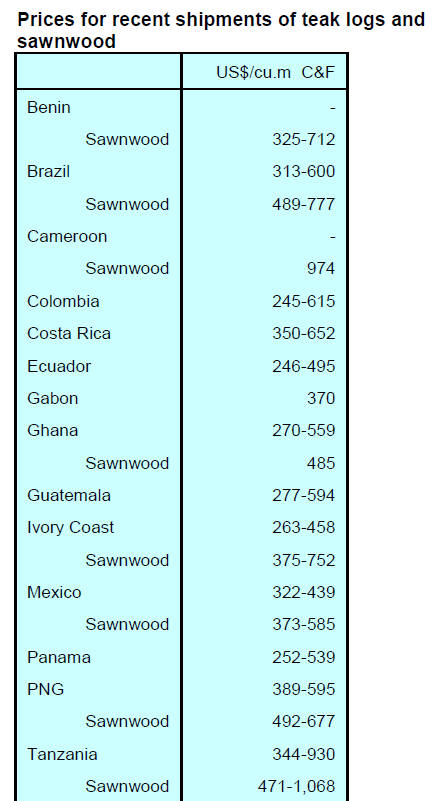
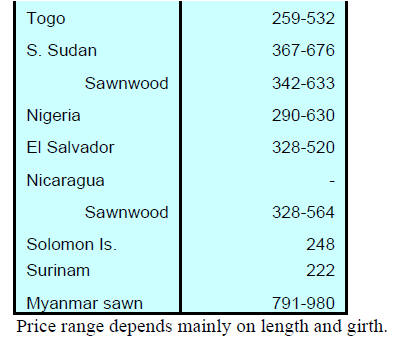
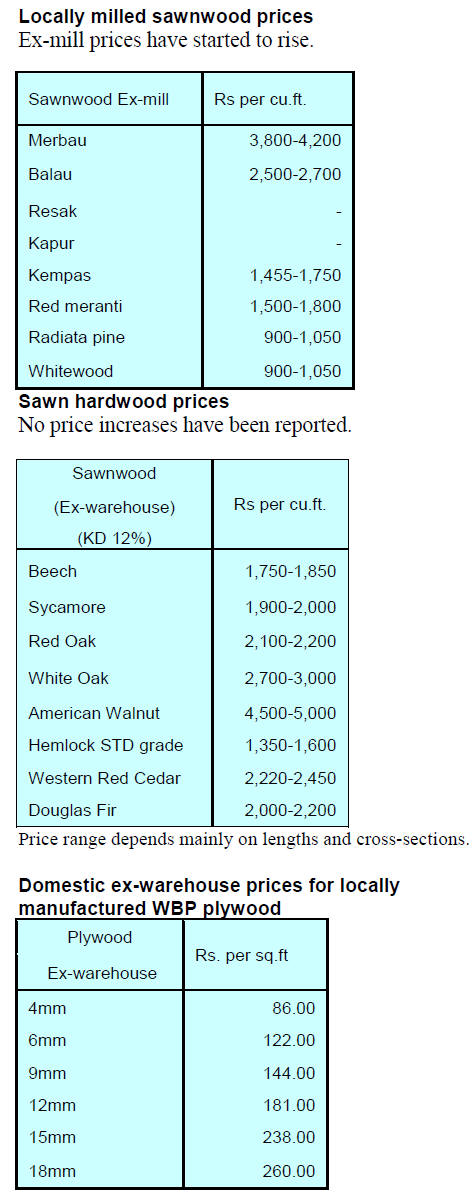
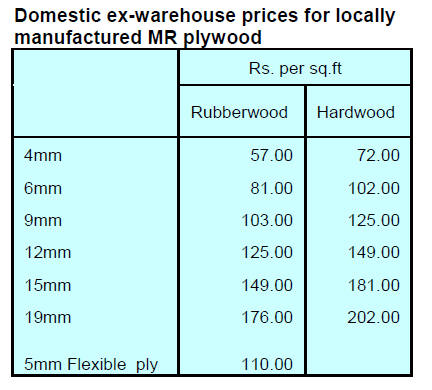
7.
VIETNAM
Exports of wood and wood products to rise in 2022
According to the General Department of Customs exports
of wood and wood products (W&WP) in April 2022 are
estimated at US$1.5 billion, up by 7.3% compared to April
of 2021.
Exports of wood products alone in April of 2022 are
estimated at US$1.13 billion, up by 6.4% compared to
April of 2021.
In the first 4 months of 2022 there were 5 product groups
with export values over US$1 billion including wood and
wood products according to the Ministry of Agriculture
and Rural Development.
The Vietnam Wood and Forest Products Association has
indicated the focus of exports is on high value-added items
such as wooden chair frames, living and dining room
furniture and bedroom furniture reflecting Vietnam's
manufacturers strengths.
The timber industries still face many difficulties such as
the prolonged Covid-19infections and control measures
which disrupted the flow of of workers and the Russian
invasion of Ukraine. These issues have pushed up energy
and fuel costs and impaced production costs.
In particular the price of wood raw materials continues to
rise but businesses had to maintain production to meet
orders.
With the positive results achieved in the first months of
2022 it is forecast that Vietnam's exports of wood and
wood products in the first half of 2022 will increase by
around 5-8% compared to the same period of 2021.
See:
http://www.asemconnectvietnam.gov.vn/default.aspx?ZID1=8&ID1=2&ID8=119356
CORRECTION
In the previous report from Vietnam it was stated that “of the total wood
and wood product export revenue of US$14.8 million around half was
manufactured from acacia”. It should read US$14.8 billion.
Vietnam becoming major wood pellet exporter
Wood pellets are an emerging export commodity in
Vietnam. The production and export of this wood product
has expanded rapidly over the past 5 years and Vietnam
has become the second largest exporter of wood pellets in
the world after the US with exports of over 3 million
tonnes per year worth around US$400 million. Japan and
South Korea are Vietnam’s largest wood pellet markets.
Exports to these two markets account for over 95% of the
total export from Vietnam.
Vietnam’s wood pellet exports 2013 – 2021
Vietnam's wood pellet exports are rising. In 2021 the
export volume reached 3.5 million tonnes, worth US$413
million. Exports have been growing at between 10-20%
annually.
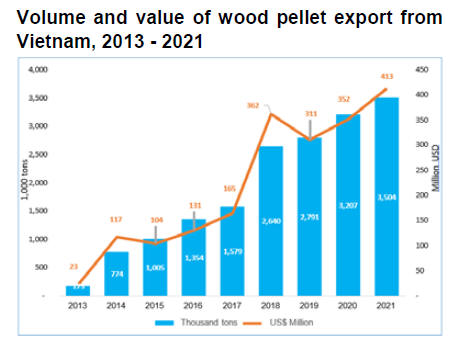
At present the volume and value of wood pellet
exports to
Japan and South Korea are almost the same. In 2021 the
export to Japan and South Korea accounted for 43.8% and
56% of total wood pellet exported by Vietnam in volume
and 48.5% and 51% in value, respectively.
Wood pellet price
The price of wood pellets exported to Japan is more stable
than the export price to S. Korea. However, the price
growth rate in the Korean market is faster than the growth
rate in Japan. In particular, in the first months of 2020 the
price of wood pellets exported to S. Korea stood at about
70% of that exported to Japan. However, at the end of the
fourth quarter of 2021 the difference in prices in these two
markets narrowed.
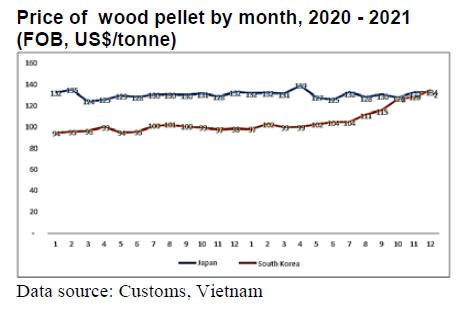
In the first months of 2022 the price of wood pellet
exported to Korea increased sharply (US$150-160/tonne)
while the price in Japanese market ranged between
US$140 - 145 per tonne. The difference in price growth in
these two markets is mainly due to differences in the
duration and term of contracts signed by the Vietnamese
enterprises.
Size of export companies
The number of companies directly involved in wood pellet
export is relatively small and has not changed much in
recent years. In 2021 83 companies were involved in wood
pellet export, just 9 companies more than in 2020 and 6
companies added in 2019.
In 2021 of the 83 companies directly involved in exporting
wood pellets 8 companies have export volumes over
100,000 tonnes per company.
The annual export volume of these 8 companies accounted
for nearly two-thirds (67%) of the total exports. Of these 8
exporters there are 3 companies with export volume of
400,000 tonnes or more including 1 company with a large
export volume (714,000 tonnes, equivalent to 20% of the
total Vietnam’s wood pellet export in the year).
Information on the export size of the enterprise reveals the
following observations:
In general, the number of wood pellet exporters is quite
small (less than 100 companies) partly due to limited direct
access to overseas markets;
Wood pellet export remains mostly with some 15 largescale
producers and exporters;
The small and micro companies represent a large
number of exporters but of small volumes.
The number of companies engaged in wood pellet
export business (83 companies) is not corresponding to the
number of the producers (over 300 actors).
Raw material sourcing
Wood raw material input for pellet production, is usually
residues from harvesting plantations and mill residues. At
present Vietnam’s wood pellet production relies on 2 types
of raw material inputs:
Wood pellet as a byproduct of sawmilling and furnituremanufacturing
factories
This type of wood pellet is produced mainly in the South-
Eastern provinces, including Binh Duong, Dong Nai, Ho
Chi Minh City which represents the major hub of
Vietnam’s wood industry. Producers in this area are using
imported raw material.
Wood pellet produced by using branches, tops of
plantation wood and other small-sized wood
Vietnam's plantation area and farm forests are
concentrated mainly in the Northern and Central regions
of the country. Wood pellet factories distributed in these
localities rely on raw material collected during plantation
harvesting and a smaller volume of residues from local
wood processing plants.
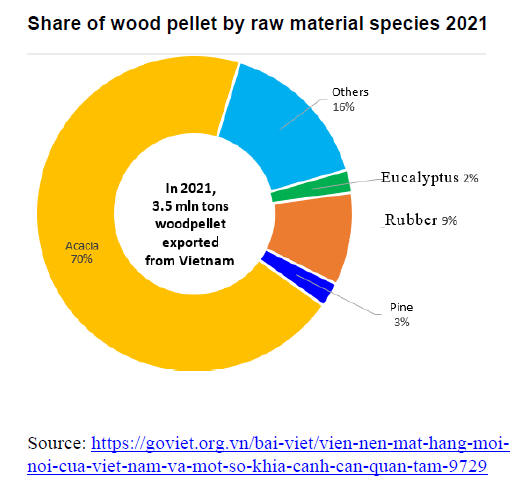
8. BRAZIL
Concession in the northern region of
Brazil
The Brazilian Forest Service (SFB) has published details
of the forest concessions available in the Amana National
Forest in Pará State. Concessionaires will be permitted to
harvest timber and non-wood forest products under
sustainable forest management plans.
The concessions comprises three forest management units
totaling 229,300 hectares with an estimated annual cut of
120,000 cu.m of logs for an annual fee of around R$4,1
million. The concession notice was posted for public
consultation during two public hearings.
It should be noted that between 2019 and 2021
concessions in federal forests delivered R$73.3 million in
fees and produced 787,850 cu.m of roundwood which
corresponded to 47% of forest production in federal
concessions since 2010.
Technology and innovation in the Brazilian Amazon
Technology is being used in Brazil to increase
productivity, generate jobs, strengthen biomes and
ecosystems and simultaneously build wealth and
sustainability. These technologies are innovative, capable
of securing the forest and support local communities.
The Brazilian programme AMAZ, coordinated by the
Institute for Conservation and Sustainable Development of
the Amazon (IDESAM), selected several companies to
receive an initial investment of R$200,000 each with the
possibility of reinvesting another R$400,00 per year at end
of the process.
Altogether the companies in the north of the country in the
states of Acre, Amazonas, Mato Grosso, Pará, Rondônia
and Roraima have the potential to guarantee more than one
million hectares of preserved forests and absorb more than
700,000 tons of carbon annually.
The businesses that participate in AMAZ have very
diverse areas delivering direct and indirect support for
conservation of the Brazilian Amazon forest such as
implementation of agroforestry production; forest
recovery; manufacture of food supplements produced with
ingredients predominantly from Amazonian communities,
reduction of negative environmental impacts through
production chains with the participation of local
communities and promoting tourism through visits in
Brazilian Conservation Units.
Furniture sector exports grow
The Brazilian furniture sector started the year 2022 with a
high level of exports. In January exports of furniture
totalled R$275.6 million, an increase of 27% in relation to
the first month of the previous year. Timber products led
exports (87%) and traded R$238.6 million according to
data from IEMI, ABIMÓVEL and Apex-Brazil.
The main destinations for furniture exports were the
United States (the main market) accounting for 36% of
exports followed by the United Kingdom at 11%. Exports
to the UK increased by 79% compared to December 2021
and by 30% over the past 12 months. Significant growth
was seen in the value of furniture exports to the
Netherlands.
After the positive great export performance in 2021 the
furniture market started 2022 on a good note optimism
according to the Bento Gonçalves Furniture Industry
Union (Sindmóveis). The main companies in the furniture
cluster in Bento Gonçalves and nearby regions (one of the
largest furniture clusters in the Southern Brazil) traded
more than US$14.2 million in the first quarter of this year,
a13% increase compared to the same period in 2021.
In the first quarter of 2022 the three main buyers of
furniture “made in Bento Gonçalves” were the United
States, Chile and Uruguay. The fastest growth among the
top ten export markets was in the United Kingdom (an
increase of 95% compared to the same period last year).
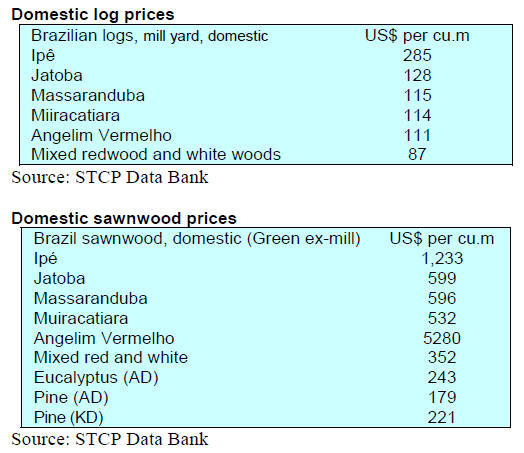
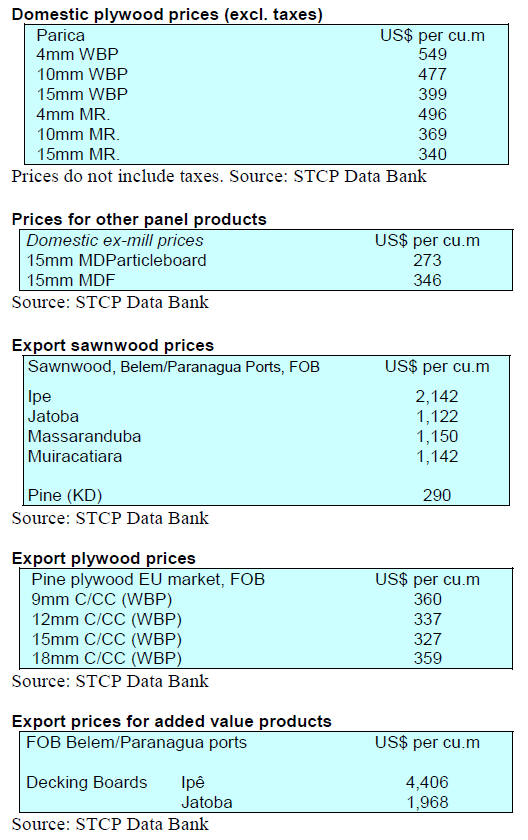
9. PERU
Jump in particleboard imports from
Brazil
Peruvian particleboard (PB) imports exceeded US$50
million in the first quarter of 2022 growing 78% in March
2022 and this drove first quarter 2022 year on year growth
to almost 40%,
Ecuador was, once again, the main supplier of PB with
shipments of US$18.1 million which represented an
increase of 24.5% year on year. Spain was the second
supplier at US$13 million, an increase of 25.2% compared
to the US$16.5 million shipped Q1 2021.
Shippers in Brazil achieved strong export growth of 66%
and were the third largest supplier of PB in the first quarter
of 2022 at US$11.4 million.
Peru commits to promote the use of sustainable wood
Peru, through the National Forestry and Wildlife Service
(SERFOR), participated in the XV World Forestry
Congress where it supported the declaration to promote
the sustainable production of wood that will conserve
forests, provide added value and mitigate climate change.
This declaration seeks to promote technical exchange,
experiences and learning in order to promote innovations
in sustainable forest management and value chains. It also
seeks to increase the use of sustainable wood-based
solutions within the Nationally Determined Contributions
by 2030.
In related news, during the 17th United Nations Forum on
Forests SERFOR General Manager, German Jaimes,
affirmed that Peru is committed to promoting sustainable
forest management to achieve the Global Forest Goals and
the implementation of the United Nations Strategic Plan
for Forests.
IMF - policy response in 2020 helped mitigate impact of
the pandemic
In cooperation with Peruvian officials the International
Monetary Fund completed a consultation on the state of
the economy at the end of April 2022.
A statement from the IMF says “Economic activity in Peru
rebounded strongly in 2021 from its deepest downturn in
decades.
The strong policy response in 2020 helped mitigate the
impact of the pandemic and created the conditions for a
rapid recovery. Progress in the vaccination campaign
allowed a gradual lifting of Covid-19 mobility restrictions.
Real GDP rose 13.3% in 2021, supported by robust
external demand, favorable terms of trade, and pent-up
domestic demand. Real GDP surpassed its pre-pandemic
level but remains below its pre-pandemic trend”.
See:
https://www.imf.org/en/News/Articles/2022/05/02/pr22138-imf-executive-board-concludes-2022-article-iv-consultationwith-peru
